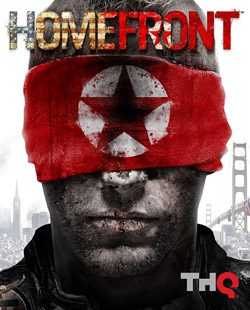Americans have always been fascinated by the zombie apocalypse, and why not? With the right tools and expertise, the zombie infestation could be a proverbial playground. When this line of thinking comes up in conversation, the same question is always asked: What would you do? It’s fun to contemplate, partially, because we all know that zombies aren’t real and that particular apocalypse could never happen. War is real though, it has been around since the dawn of man, and it has been fought on nearly every square inch of the earth’s soil. Therefore, is it really so farfetched to think that war could one again come to US soil, or that our great nation could fall? Let’s replace zombies with, say, a militant occupation. Would you do anything different? In Homefront, the same rules apply – fight, run, survive.

Platforms: Xbox 360, Playstation 3, PC, OnLive
Developers: Kaos Studios, Digital Extremes (PC)
Publisher: THQ
$59.99
Story
The year is 2027 and the once great United States, after two decades of war and economic woes, has fallen to the Greater Korean Republic – a nation formed from a unified North and South Korea. You play as Robert Jacobs, a former marine helicopter pilot who is trying to keep a low head during the Korean occupation of his hometown, Montrose, Colorado. The game begins with Jacobs being arrested by Korean officers for “failing to answer draft orders,” and is loaded onto a bus for transport to a “reeducation camp.” After a brief ride through town that highlights the horrors of a brutal militant occupation, Jacobs is saved by a band of resistance fighters and taken to the “Oasis” – their self-sustaining and heavily camouflaged home base. Once there, Jacobs is introduced to the leader of the group, Boone Karlson and the other fighters. He is also filled in on the resistance’s plans to hijack a number of Korean-controlled fuel tankers that are to be re-purposed for the American forces’ use.

I was initially attracted to Homefront because it’s story was written by John Milius, who also helped write the movies Apocalypse Now and Red Dawn, and my hopes were, for the most part, realized. One part that I liked in particular was the opening cut-scene, which takes players through a time-line of events that justify the state of the US. It does a good job of making the Korean occupation plausible, and in turn allows the player to become more immersed in the story. Once in the actual gameplay, I found that the environments were one of the game’s strongest elements; throughout most of the game, players fight through suburbs, strip malls, and schools, and all of it feels familiar.

As much as I enjoyed the story, I was baffled when the credits started to role after the Golden Gate Bridge battle, which brings up the game’s single biggest letdown, – the short campaign. I was able to beat the game (start to finish) in about four and a half hours, or one day, and that is just unacceptable for a game that costs $60. It’s also a letdown from a storytelling standpoint because it leaves gamers with a cliffhanger ending that is far too obvious (US forces have supplies and backing from allies? I wonder what will happen to those nasty Koreans in the next installment).
Gameplay
Graphically, Homefront looks good, and since it is running on the Unreal 3 engine, it has no reason not to. The game’s main issues stem from poorly designed AI that seemed hell-bent on ruining the game for me. Friendly AI was consistently unaware of its surroundings, and would either hide behind cover and not fight at all, or would completely disregard the enemy and walk out from cover as if nothing was happening. It’s no big deal though, after playing countless military shooters I’m used to fighting battles alone, the main problem is that most missions are structured as “follow the AI,” and when the AI doesn’t know where to go or doesn’t know to open the door then it’s a big deal.
A lot of focus has been put on Homefront’s multiplayer, and after finishing the campaign I was looking forward to, what could be, the game’s biggest redeeming factor, but what I found was an experience that was largely mediocre. The multiplayer’s standout feature is its battle points system, which awards player for getting kills or taking objectives with points that can then be used in the match to purchase anything from ammo to tanks. This system is an improvement on the Call of Duty killstreak system, in my opinion, because it promotes teamwork and objective thinking over the camping and cheap killing. Unfortunately, there is nothing else that really makes the Homefront multiplayer standout. It does boast a leveling system very akin to COD, with perks and weapon customization, but most multiplayers are taking that direction.

Verdict
Homefront establishes the foundation for what could become a great piece of speculative fiction, and I hope that Kaos Studios will continue to explore the storyline(s) of this apocalyptic future. As it stands now though, it is hard to recommend the game, partially because the campaign is so short and partially because multiplayer is nothing that will pull gamers away from COD or Halo.
[rating:3/5]


